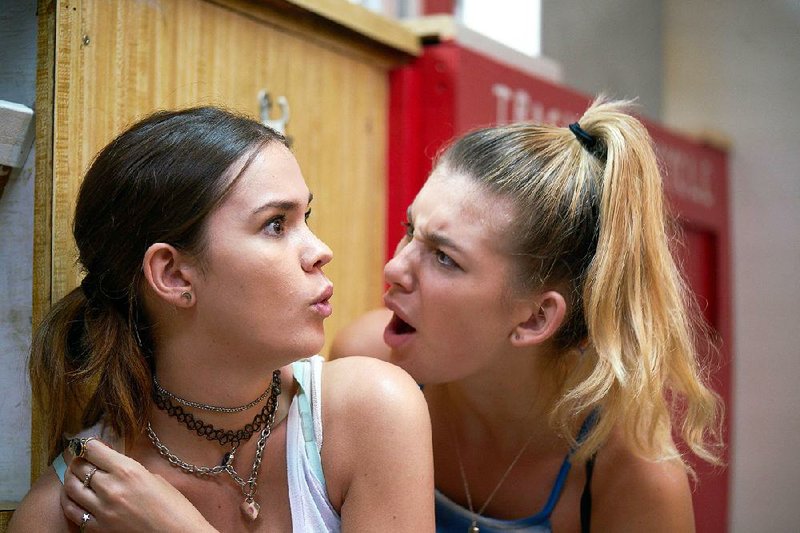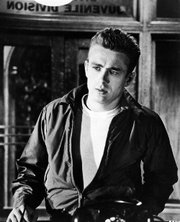I almost never watch a movie twice within a couple of weeks. But I recently made an exception for Augustine Frizzell's Never Goin' Back, a raunchy shaggy-dog tale about two 16-year-old girls living without adult supervision in the slipping-down suburbs of Dallas.
Never Goin' Back -- which will hit home video Oct. 30 -- is not a great film by any means, and almost everyone involved with it will soon go on to do better things. Like many movies, it doesn't know how or when to end. But it is a likable and fairly accurate portrait of what we might ironically call bored stupid youth. Angela (Maia Mitchell) and Jessie (Camila Morrone), the best friends at the center of the film, are neither stupid nor boring -- though they often sound and behave like a distaff Beavis and Butt-head.
Mike Judge's characters starred in a smart show about dumb people.
Never Goin' Back is an irrationally effervescent movie about intelligent characters who've chosen a sort of hedonist nihilism in the face of hopelessness. If nothing matters, why not blow the rent money on a trip to Galveston?
We haven't seen teen characters like this before -- at least not recently. While the cineplexes are flooded with fantasy, dystopian and romantic films derived from young adult literature (teen striving is the theme of both Lady Bird and the Hunger Games series), and there's a tradition of grim, naturalistic stories of wasted youth like River's Edge, The Basketball Diaries and Larry Clark's Kids, rarely do we see troubled kids portrayed with such empathy and wit. We like Angela and Jessie, even if Never Goin' Back feels pretty pointless.
That it's not for everybody goes without saying. These days all movies are niche products.
. . .
That wasn't always the case. In the 1930s and '40s, everyone went to the movies. And a lot of movies aspired to be for everybody.
Will H. Hays, president from 1922 to 1945 of the Motion Picture Producers and Distributors of America, is best known for the so-called Hays Code, a set of moral guidelines applied to most U.S. motion pictures released by major studios from 1930 to 1968. Hays had an interesting view of the industry that he was paid handsomely to defend and protect. He always insisted that, unlike classical music or other elevated art forms, the commercial nature of movies required them to be "art for the millions .... speaking the language of all men of all ages."
The former head of the Republican National Committee and U.S. postmaster general, Hays was enlisted to rehabilitate Hollywood's image after dozens of scandals and a proliferation of risque films in the 1920s. There were nearly 100 bills introduced in state legislatures across America seeking to ban or censor the movies.
But in the years following World War II, things began to change. The collapse of the studio system opened the door to foreign and independent films that were not bound by the Hays Code. The Supreme Court held that the major studios' distribution model (studios owned their own theaters) was in violation of antitrust laws and that film was an artistic medium protected under the First Amendment. This decision weakened the code by eliminating the spectre of government censorship of film, which was the only reason the studios subscribed to it in the first place.
Add to that the rise of television and post-war prosperity which allowed Americans to experience a transitional period between childhood and full adulthood -- the invention of the teenager -- and you begin to see the erosion of the universality of movies. Filmmakers began to focus on specific markets, and by the mid-'50s it was apparent that the most lucrative of these markets was that group defined by discretionary income, leisure time and specific social needs.
So Nicholas Ray, who'd begun his directing career in 1949 with They Live By Night, a movie about a young couple "never properly introduced to this world" on the run from the law, makes Rebel Without a Cause, a movie about angsty middle-class teens. Rebel opened in October, five months after Richard Brooks' Blackboard Jungle, a social commentary film about teenagers that was marketed as a cautionary tale to adults. While both films have their merits, it's interesting to note the difference in attitudes toward their subjects.
In Rebel, the teenagers seemingly exist in a bubble, largely insulated from the adults who have little bearing or status in their world. In Blackboard Jungle, the focus is on Glenn Ford's character, the teacher Richard Dadier, who seeks to connect with the disaffected youth in his charge (chief among them the splendid young Sidney Poitier as a musically gifted rebel).
But if the teen movie was born with movies positing adolescence as existentially dangerous territory (the idea of juvenile delinquency predates the idea of the teenager as a preferred demographic -- see 1937's Dead End, which featured Humphrey Bogart and the first appearance of the ensemble that would become known as The Dead End Kids) -- these were soon superseded by relatively benign beach movies (the Gidget movies and American International Pictures' Beach Party films with Annette Funicello and Frankie Avalon), which gave way to coming-of-age films like James Goldstone's Red Sky at Morning and Robert Mulligan's Summer of '42 (both 1971).
In 1979, Cameron Crowe went back to high school and wrote the book Fast Times at Ridgemont High. Three years later Amy Heckerling turned it into a kind of Animal House for the jailbait crowd. In 1989, Crowe closed out the decade by directing the sublime Say Anything ... , which made a star of John Cusack. Then there was Martha Coolidge's 1983 cri de coeur Valley Girl, starring Nicolas Cage and fetchingly over-bitten Deborah Foreman. And John Hughes had his run of teen dramedies: Ferris Bueller's Day Off, The Breakfast Club, Sixteen Candles and Weird Science were slight but earnest bits of pop craft that offered teens mildly flattering mirrors in which to gaze.
. . .
Post-Columbine, we've seen the rise of school shooter movies, ranging from the detestably exploitative Duck! The Carbine High Massacre, a low-budget direct-to-video spoof thrown together mere months after the 1999 shootings, to thoughtful and provocative movies like Gus Van Sant's elliptical and crushing (and Palme d'Or-winning) Elephant (2003) and Lynne Ramsay's flawed but unsettling We Need to Talk About Kevin (2011).
It's easy to see why filmmakers seem drawn to the material; technology has made it possible for children to kill with high efficacy. (In his contemporary review of Blackboard Jungle, the Washington Post's Richard L. Coe wrote; "The papers regularly have news about shocking conditions in the schools.Vandalism certainly is more rampant than it was only a few years ago. Sex crimes and thuggery do occur. Even murder is not beyond our young.")
Sentimental notions of childhood innocence, parental concerns for the safety of their kids and the mysterious adolescent curdling of previously delightful boys and girls into angst-ridden adolescents all come into play.
Teenagers are remarkably vulnerable even as they believe themselves bulletproof. We laugh at the druggy antics of Angela and Jessie, but part of the movie's pull is its verisimilitude. There's a sense that kids like them exist.
Email:
blooddirtangels.com
Style on 09/16/2018


